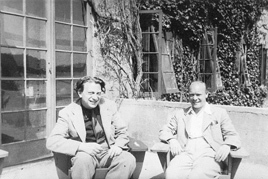1938: Protein Chemistry, Vol. VI
Organizer: Eric Ponder
Proteins are now so well understood and so much a part of our knowledge that it is almost impossible to put ourselves in the position of the participants in the 1938 Symposium. For example, in that year, Linderstrom-Lang, Hotchkiss and Lang had written in Nature that their data on protein denaturation "..provide sufficient basis for giving a warning against the conclusion that genuine proteins contain peptide bonds..." And, as late as the 1949 Symposium, Fred Sanger could write that his results with insulin "...suggest that each position in a protein chain is occupied by a single unique amino acid residue...it does suggest that proteins are real chemical entities with a unique structure...". The 1938 Symposium was attended by many of the most (or soon to be) eminent protein chemists of the day—Max Bergmann, Edwin Cohn, John Edsall, Joseph Fruton, Hans Neurath, Carl Niemann, Dorothy Wrinch, and Ralph Wyckoff—and it provides an illuminating snapshot of the uncertainties and confusion that surrounded the nature of proteins.
Niemann, for example, discussed a theory of protein structure developed by himself and Bergmann. They believed that the total number of amino acids in a protein could be expressed in the from 2n x 3m, and that each amino acid occurred at the same interval along the polypeptide chain—A.B.C.A.B.C.A.B.C etc. A numerological approach was also the foundation of Wrinch's cyclol or fabric theory of protein structure. On
| 
the other hand, Fruton presented experimental data showing that proteinases were able to cleave the peptide bond in synthetic peptides, suggesting that that was their mode of action on native proteins. Wendell Stanley (who was to win the Nobel Prize in Chemistry in 1946) had crystallized Tobacco Mosaic Virus only three years earlier and he discussed, among other topics, his attempts to produce an infectious viral protein.
Descriptions of biophysical studies were, of course, much in evidence. Irving Langmuir (Nobel Prize in Chemistry, 1932) described his studies of proteins spread as monomolecular films while William Astbury described his and Florence Bell's X-ray crystallography studies, interpreted in terms of Bergmann and Niemann's ideas. Astbury's paper is interesting also as the first occasion on which an X-ray crystallographic analysis of DNA was presented. Astbury elaborated on his note in Nature that had appeared two months earlier, and showed a diagram of his "pile-of-pennies" model. — Jan A. Witkowski |